When repairing a bathroom, it becomes necessary to replace the heated towel rail, and if it is not there, to install it. The choice of heated towel rails is quite wide: various materials, firms, color, design, connection methods. Which water heated towel rail for an apartment is better to choose and how to connect it, what options, reviews, photos can be - this will be discussed in the material below.
Why is this device needed?
The answer is in the name, but in addition to drying towels, this technique also serves to heat the room. The heated towel rail, in addition to its main task, acts as a radiator in the bathroom - and this should also be taken into account when choosing.
Advice. In the hot season, a running hot heated towel rail in the bathroom can create discomfort, so be sure to provide for the possibility of turning it off if necessary.
What are water heated towel rails
Connection classification:
- with lateral connection;
- with bottom connection.
What does it affect? In general, from the point of view of operation - no difference. This parameter is important only from the point of view of the convenience of approaching the heated towel rail,
Towel warmers can be made from various materials:
- ordinary steel;
- copper;
- brass;
- aluminum.
The appearance of a water heated towel rail on the example of one of the market models
Carbon steel towel rails
Such heated towel rails are attracted primarily by their low price. However, their obvious drawback is susceptibility to corrosion, so their service life is much less than that of heated towel rails made of any other materials. For this reason, such heated towel rails are becoming less and less common - they are gradually becoming obsolete. And although there are steel heated towel rails that provide anti-corrosion protection (internal coating of pipes), this leads to a significant increase in their cost, which negates their main advantage - low cost. The only advantage of a steel heated towel rail in this case is its high mechanical strength, the ability to withstand significant water hammer, and the ability to operate at more high pressure in the pipeline than towel warmers made of other materials.
Stainless steel towel rails
In terms of its strength and reliability, such a heated towel rail is practically not inferior to ordinary steel, and significantly surpasses it in anti-corrosion properties. And although stainless steel heated towel rails are much more expensive, they are the most widely used.
It is worth noting one important feature stainless steel towel warmers - they can be subject to corrosion due to the so-called "stray currents". This "scarecrow" is quite common, therefore, obviously, it is worth figuring out what the danger is and how high its probability is.
The fact is that the appearance of an electric potential on any metal object becomes impossible if it is grounded. Riser pipes for hot water supply and heating in residential buildings grounded without fail. But due to the use plastic pipes when connecting the heated towel rail to the riser electrical contact between them occurs through water, which has significant electrical resistance, and in this case, a potential difference may occur between the heated towel rail and the riser. However, this can be avoided by studying the issue in advance and performing simple steps to ground the heated towel rail on metal pipes riser.
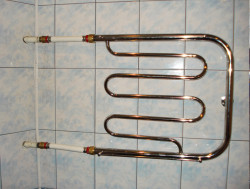
Stainless steel towel rail unusual shape: good design solution for an apartment
Copper and brass towel warmers
Such heated towel rails are quite expensive. Copper as well as brass heated towel rails are not subject to corrosion, and although their mechanical strength is lower than that of steel products, it is quite enough for a good heated towel rail. Most of all, such heated towel rails are suitable for autonomous heating systems made copper pipes They will feel like family there. But if you like just such a heated towel rail, it can be used to connect to central heating or hot water supply - there are no contraindications here.
aluminum heated towel rail
Such heated towel rails are the least common, in contrast to the widespread aluminum radiators heating. They are resistant to corrosion, and their main advantage is their low weight compared to heated towel rails made of other metals. Aluminum heated towel rails have a rather complicated manufacturing technology - aluminum cannot be welded and soldered, therefore aluminum heated towel rails can be either solid-cast or require technological tricks to connect parts. Therefore, as a rule, aluminum heated towel rails are found only in imported, expensive brands. This option is for an amateur who "will not stand up for the price."

Bottom water heated towel rail with radiator: functional option to the bathroom
Connecting a heated towel rail
A frequently discussed question: where is it better to connect a heated towel rail - to a heating system, or all the same to a hot water supply system? The following answer is usually given: when a heated towel rail is connected to heating, it will only function during the heating season, so it must be connected to the DHW system in order for it to work all year round. But this is only partly true. Firstly, in many cities there is no hot water in the summer, and secondly, in the hot season, a heated towel rail in the bathroom may simply be undesirable, because, as already noted, it also performs the function of a heating radiator.
Much more important when choosing a connection method is the fact that there are usually no heating risers in the bathroom, and the supply of heating pipes from other rooms (from the kitchen or from the room) is extremely difficult, and often simply impossible. Therefore, for an apartment, in most cases, connecting a heated towel rail to the DHW system is the only possible option. Another thing is a house or apartment with independent heating. Both options are possible here, but you need to take into account that in order to include a heated towel rail in the DHW system, it is necessary to organize a hot water recirculation system: simply connecting a heated towel rail between the boiler and the tap is not good here.
Attention! Before buying and installing a heated towel rail in an apartment, make sure that you have a properly functioning hot water recirculation system. In some low-rise buildings of the old building, it is simply absent - and in this case, connecting a heated towel rail to the hot water system becomes meaningless - it will not work.

Wiring diagrams and the lineup water heated towel rails
Appearance, design, coating
The most common color for a heated towel rail is chrome, White color- the second most popular. But this does not mean that other options are impossible - today it is possible to order a heated towel rail of almost any color, even the most exotic one. And copper and brass heated towel rails are often found stylized as old bronze or even gold.
In shape, heated towel rails are most often “snakes” or “ladders”, in various variations. Sometimes additionally equipped different kind shelves or coasters - there is no limit to the imagination of designers.
If you want to install a large (almost the entire wall) heated towel rail in a small bathroom, it would be useful to provide temperature control on it so that there is no overheating small room large heater.
Video: How to approach the purchase of a water heated towel rail
And they have a snake-like appearance. Their functions are reduced to being a dryer for clothes and towels, because in such a humid room as a bath, things dry very slowly. In addition, a heated towel rail is also an element that can improve the microclimate, and you can comfortably get out of a hot bath or shower without getting goosebumps. An additional bonus is the prevention of condensation on the mirror and some other surfaces, which is also important. Such an element becomes a real necessity in a modern bathroom. How to choose the right heated towel rail, which will be the most suitable in terms of parameters for this room? What to look for, and which manufacturers can be trusted?
Types of heated towel rails
Today, water and electric heated towel rails are widespread, and each of them has its own undeniable advantages and disadvantages. It is impossible to clearly distinguish which of them is better, since the choice must be based on the prevailing conditions.
Water heated towel rails
 This is the simplest and most popular option, which, as a rule, is included in the standard equipment of a bathroom in apartment buildings. Such a heated towel rail is a curved pipe through which hot water circulates from the hot water supply system of the house. To the benefits This option can be attributed to ease of operation, durability, low price of the device, as well as the absence of additional fees during operation.
This is the simplest and most popular option, which, as a rule, is included in the standard equipment of a bathroom in apartment buildings. Such a heated towel rail is a curved pipe through which hot water circulates from the hot water supply system of the house. To the benefits This option can be attributed to ease of operation, durability, low price of the device, as well as the absence of additional fees during operation.
At the same time, the water heated towel rail also has some shortcomings. The key one is the dependence on the supply of hot water: if it is carried out or simply turned off, then the bathroom will be cold and damp. If we are talking about a private house where they use offline sources heating and water heating, then you can safely stop on a water heated towel rail. It is also worth noting that it warms up quite slowly, and from turning on the hot water until the moment it is warm in the bathroom, time will pass. But even despite these disadvantages, water heated towel rails are now the most popular option.
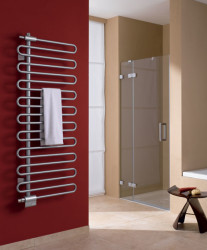 Given the unstable pressure in the water supply networks apartment buildings, when buying a water heated towel rail you need pay attention first of all to then, on what is the working and maximum pressure it is calculated, and then compare this indicator with the pressure in the network of a particular house. The rules state that all elements water supply network houses must withstand a pressure of 6 atmospheres, it is normal to cope with pressure testing, when a couple of times a year, in order to check, the pressure can rise to 10 atm. At the same time, according to the standards, the operating pressure of the coolant is 4 atmospheres. But, as many have already seen, own experience, indicators do not always correspond to certified standards. So, depending on the season, the house, the number of floors and the state of communications, the pressure can be either 2.5 atm or 7.5 atm. That is why the probability of water hammer and pressure increase should be considered when choosing a heated towel rail. Another thing is if you live in a private house where the pressure is internal system actually never exceeds 2-3 atm. In this case, the choice of different options for heated towel rails is expanding.
Given the unstable pressure in the water supply networks apartment buildings, when buying a water heated towel rail you need pay attention first of all to then, on what is the working and maximum pressure it is calculated, and then compare this indicator with the pressure in the network of a particular house. The rules state that all elements water supply network houses must withstand a pressure of 6 atmospheres, it is normal to cope with pressure testing, when a couple of times a year, in order to check, the pressure can rise to 10 atm. At the same time, according to the standards, the operating pressure of the coolant is 4 atmospheres. But, as many have already seen, own experience, indicators do not always correspond to certified standards. So, depending on the season, the house, the number of floors and the state of communications, the pressure can be either 2.5 atm or 7.5 atm. That is why the probability of water hammer and pressure increase should be considered when choosing a heated towel rail. Another thing is if you live in a private house where the pressure is internal system actually never exceeds 2-3 atm. In this case, the choice of different options for heated towel rails is expanding.
Electric towel warmers
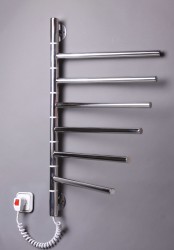 Great alternative water heated towel rails - their electrical counterparts. This option is ideal when interruptions in the supply of hot water happen regularly, and you no longer want to depend on the presence of it in the pipes, on its pressure, on quality composition etc. Electrical devices most often they have a pleasant design, they are mobile and autonomous, they do not require connection to the water supply network. To start using such a device, simply fix it on the wall and plug it into a power outlet. That is why they can be used not only in bathrooms, but also in the kitchen or hallway, for example.
Great alternative water heated towel rails - their electrical counterparts. This option is ideal when interruptions in the supply of hot water happen regularly, and you no longer want to depend on the presence of it in the pipes, on its pressure, on quality composition etc. Electrical devices most often they have a pleasant design, they are mobile and autonomous, they do not require connection to the water supply network. To start using such a device, simply fix it on the wall and plug it into a power outlet. That is why they can be used not only in bathrooms, but also in the kitchen or hallway, for example.
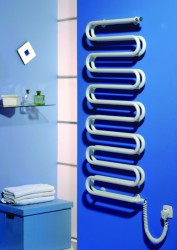 Electric heated towel rails are much more convenient to use, since almost all models are equipped with a control system: you can set any desired temperature and adjust it in the process. It is also the only possible variant install the heated towel rail without destroying existing system water supply, if such an element was not previously designed. problems with bad water, which causes corrosion of the material, will also not be, which can be considered significant advantage.
Electric heated towel rails are much more convenient to use, since almost all models are equipped with a control system: you can set any desired temperature and adjust it in the process. It is also the only possible variant install the heated towel rail without destroying existing system water supply, if such an element was not previously designed. problems with bad water, which causes corrosion of the material, will also not be, which can be considered significant advantage.
Minuses such models also have, and the main one is an increase in payment for electricity. In addition, you will need to take care of safety, because in such a humid room as a bath, an electrical appliance will always be present. It is better to provide splash protection for the outlet and think in advance so that it does not get under your feet and does not really spoil the interior of the bathroom.
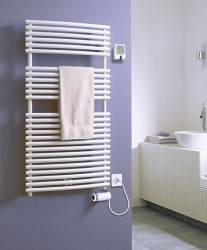 When choosing an electric towel warmer It is worth paying attention not only to its shape and size, but also to power consumption and the presence of a thermostat. Naturally, the more economical the heated towel rail, the better for the family budget. As for management, there are two options. The first of them is as simple as possible: there is a thermostatic head, with which it is manually regulated temperature regime. The second option has a higher cost and advanced functionality. The user only needs to specify comfortable temperature indoors, and the heated towel rail will support it on its own. Some devices are additionally equipped with a timer, with which you can set the mode for a day or a week. Such functionality allows not only to use electricity more rationally, but to make your life more comfortable. So, for example, the timer can be set so that when you come home or wake up from sleep, towels and bathrobes are warm.
When choosing an electric towel warmer It is worth paying attention not only to its shape and size, but also to power consumption and the presence of a thermostat. Naturally, the more economical the heated towel rail, the better for the family budget. As for management, there are two options. The first of them is as simple as possible: there is a thermostatic head, with which it is manually regulated temperature regime. The second option has a higher cost and advanced functionality. The user only needs to specify comfortable temperature indoors, and the heated towel rail will support it on its own. Some devices are additionally equipped with a timer, with which you can set the mode for a day or a week. Such functionality allows not only to use electricity more rationally, but to make your life more comfortable. So, for example, the timer can be set so that when you come home or wake up from sleep, towels and bathrobes are warm.
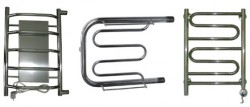 As you might guess from the name, combined heated towel rails are a compromise and can receive heat from both hot water and electricity. IN Lately such devices are becoming more and more popular, although they are still few in production.
As you might guess from the name, combined heated towel rails are a compromise and can receive heat from both hot water and electricity. IN Lately such devices are becoming more and more popular, although they are still few in production.
Combined heated towel rails combine the advantages of both types of devices, and the reliability of the design as a result only increases. This option is also indispensable in the case when hot water is turned off in summer: in this case, in winter you can save money and use the device as a water heated towel rail, and in summer turn it on if necessary and set the desired mode using electricity.
The only one disadvantage of this solution- high price, which scares off many potential buyers.
Towel dryer material
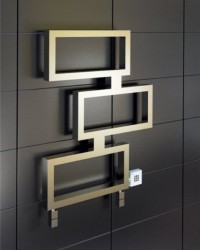 If your choice is on a water heated towel rail, then the material of its manufacture should be looked at especially carefully. The main danger in this case is water in the system. central water supply, which often does not meet the standards, is saturated with oxygen, salts, and ultimately leads to the development of corrosion processes, clogging, which gradually disables the heated towel rail. So, what material will be the most durable and durable?
If your choice is on a water heated towel rail, then the material of its manufacture should be looked at especially carefully. The main danger in this case is water in the system. central water supply, which often does not meet the standards, is saturated with oxygen, salts, and ultimately leads to the development of corrosion processes, clogging, which gradually disables the heated towel rail. So, what material will be the most durable and durable?
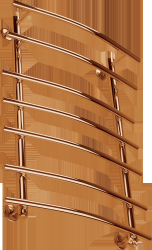
These are the most popular and most represented types of heated towel rails, although stone and even glass products can also be found in the elite collections of some foreign manufacturers.
Towel dryer power
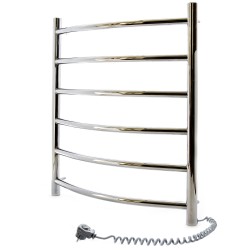 The power of the heated towel rail plays important role: a properly selected device will fully cope with all the tasks assigned to it. It is necessary to build on the choice of the dimensions of the bathroom, as well as the functions assigned to the heated towel rail. So, if the task is simply to dry linen and towels, then the power is enough at the rate of 100 W / m 2 or 40 W / m 3. These are old Soviet norms that require maintaining the temperature in the bathroom at +18 0 С.
The power of the heated towel rail plays important role: a properly selected device will fully cope with all the tasks assigned to it. It is necessary to build on the choice of the dimensions of the bathroom, as well as the functions assigned to the heated towel rail. So, if the task is simply to dry linen and towels, then the power is enough at the rate of 100 W / m 2 or 40 W / m 3. These are old Soviet norms that require maintaining the temperature in the bathroom at +18 0 С.
If you want the heated towel rail to also serve as a heater, then it is better to use other norms when calculating: 140 W/m2 or 56 W/m3. Thus, for example, for a bathroom with an area of 3.5 m 2, a heated towel rail with a power of 490 W will be enough.
Design and dimensions
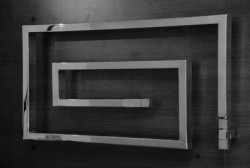 Considering all the moments of functionality and reliability, do not forget about the aesthetic component. It is important that the heated towel rail fits into the bathroom in size, does not interfere with free movement, and fits into the interior. In addition, you also need to be able to choose the model that is most convenient for you, because the number of bends and crossbars can be different. Moreover, the shape of the device can be so bizarre and unusual that it will become not only convenient, but also a beautiful addition to the bathroom.
Considering all the moments of functionality and reliability, do not forget about the aesthetic component. It is important that the heated towel rail fits into the bathroom in size, does not interfere with free movement, and fits into the interior. In addition, you also need to be able to choose the model that is most convenient for you, because the number of bends and crossbars can be different. Moreover, the shape of the device can be so bizarre and unusual that it will become not only convenient, but also a beautiful addition to the bathroom.
If there was no heated towel rail in the bathroom before, then you can choose, in principle, any one in shape and design. Those who got the bathrooms with the old M- or U-shaped option of a heated towel rail, it is worth considering carefully whether it is worth changing it, and to which one. In domestic apartment buildings, the heated towel rail also performs the function of a compensating loop. The point is that the whole system water pipes the house is combined, and according to the laws of physics, the pipes can lengthen slightly when the temperature rises, and shorten when it drops. If you imagine this whole process on a scale of the whole house, then something like an accordion comes out, in which towel warmers play a key role, thanks to them the risk of accidents during temperature changes is reduced. It is not difficult to imagine what will happen if something is radically changed in the bathroom, so it is better to try to choose a heated towel rail that will fit into the place of the old and boring one as much as possible.
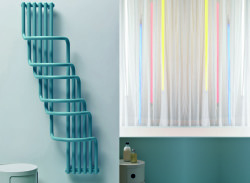 As for the form, today the simplest heated towel rails M- and U-shaped. There are also snake-like variants with lots of curves. Another popular option is stairs which differ in their advantages. Many call this option more convenient and practical, since more things fit on the ladder and they can be dried along the entire length.
As for the form, today the simplest heated towel rails M- and U-shaped. There are also snake-like variants with lots of curves. Another popular option is stairs which differ in their advantages. Many call this option more convenient and practical, since more things fit on the ladder and they can be dried along the entire length.
A heated towel rail in the form of a snake also has advantages: it is two times cheaper, and it is easier to install it if the apartment already had similar device- you won’t have to redo the riser and adjust everything to the new model.
But on this various options designs of a heated towel rail do not end, because there are so-called design radiators who can really become stylish decoration rooms. Such interesting models are presented mainly in the assortment of foreign manufacturers: these can be towel warmers rotating by 180 0, perforated models with rounded holes, and other most unimaginable options.
In addition to all the above tips, when buying, you also need to check all related product documents also does not hurt inspect the surface: it should be smooth and even. If the price for a certain model is several times lower than elsewhere, then you should think about the quality of such a heated towel rail. And in order not to miscalculate, you need to be aware what are the key manufacturers in this market and who can be trusted.
![]() Imported products bribe us with their thinner and more elegant appearance, diversity, but still, when choosing such heated towel rails, you need to be extremely careful. The thing is that in Europe, for example, heated towel rails are connected not to a hot water supply system, but to a heating system, for which water undergoes appropriate treatment. Consequently, these devices, which do not have an anti-corrosion coating and feel great in European countries, may not be durable here, because they are not adapted to pressure drops and the aggressive composition of the coolant. However, import manufacturers don't want to lose Russian market, That's why offer and adapted to local conditions heated towel rails. When choosing, you should pay attention to this and carefully consider how this or that model is suitable.
Imported products bribe us with their thinner and more elegant appearance, diversity, but still, when choosing such heated towel rails, you need to be extremely careful. The thing is that in Europe, for example, heated towel rails are connected not to a hot water supply system, but to a heating system, for which water undergoes appropriate treatment. Consequently, these devices, which do not have an anti-corrosion coating and feel great in European countries, may not be durable here, because they are not adapted to pressure drops and the aggressive composition of the coolant. However, import manufacturers don't want to lose Russian market, That's why offer and adapted to local conditions heated towel rails. When choosing, you should pay attention to this and carefully consider how this or that model is suitable.
When choosing foreign-made models, it is important to check whether they have stopcocks, thanks to which it is possible to release excessive pressure, eliminate air congestion, thereby normalizing the operation of the device and contributing to uniform heating of the heated towel rail.
So what are foreign manufacturers have proven themselves among domestic users?
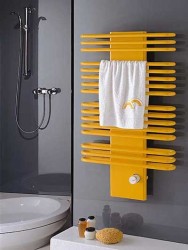
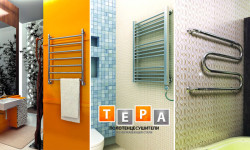
When decorating a bathroom, a necessary, I would even say, a necessary thing is a heated towel rail. After all, there are really a lot of benefits from it - this is drying your things, warming up the room (and he does it really well), if there is a heated towel rail, then the occurrence of fungi on the walls decreases significantly. In general, you need to put it (be sure to read the article -), but which one to choose really raises the question, when I chose, I traveled around a bunch of different stores and today I pass it on to you useful information …
Let's start with a little definition.
Towel dryer – This is a heating device that is mainly used in the bathroom (for drying clothes - towels, as well as for heating the bathroom). It is a bent pipe made of chrome-plated or non-ferrous metals, mainly connected to hot water supply (hot riser). If there is no hot water in the house, then a dryer that is heated by electricity can be used.
When choosing a heated towel rail, you need to solve several problems.
1) Type of connection
3) Material
4) Price - quality
And now in more detail...
1) Type of heated towel rail connection
As I already wrote, there are two main ways to connect - this is in the main hot water riser and electric (in a regular outlet). In fairness, it should be noted that now a third type is beginning to appear - combined (it performs the functions of both an electric and a flowing heated towel rail).
Flow (or water) heated towel rail - the most common, it is connected to the hot water pipe and heated from this water. In large houses, water circulates through pipes, so the risers and towel warmer are always hot.
Pros:
- does not use electricity
Minuses:
- if there is no hot water - accordingly cold
- a limited attachment point, it is not so easy to put it anywhere, you need to pull pipes, and this is not always possible. And if the pipes are not stretched correctly, then it will not heat up, or it will be very bad.
Electric towel warmer - is gaining popularity, it is installed mainly in houses where there is no hot water (for example, "Khrushchev", private houses, etc.). It does not crash into the main plumbing system - it uses TEN inside to heat water, which heats up the liquid of which the heated towel rail is filled (usually oil) - then this heat is transferred to the walls.
Pros:
— not dependent on hot water supply, pipes for connection are not needed
- can be installed anywhere, not only in the bathroom, but also in the kitchen for example.
Minuses:
- It consumes electricity, albeit a little, as the manufacturers assure about 150 - 200 W, but still!
- In wet rooms, you must comply with the requirements for the placement of electrical appliances, I touched on this a little in the article - (be sure to read if you are considering an electric option).
A short video about electric towel warmers
Combined heated towel rail - this option combines the advantages of flow-through and the advantages of electric dryers, it is connected to the central water supply system, but if there is no hot water, then it can be connected to an outlet. Cons - this is something that is not so common on the shelves of the city, a relatively new product.
2) Form
Now let's talk a little about the form, here, as they say, guys taste and color. There are dozens, if not hundreds of shapes and sizes of towel warmers. However, you need to understand the larger the heated towel rail, the better the heating and drying of the laundry. Therefore, I advise you to choose the so-called ladders (made in the form of stairs) . Laundry can be placed directly as on a stationary dryer. YES, and it warms up the bathroom better, thanks to its area. - they are the cheapest, but also the most stupid - the guys are really not practical. Just a single pipe, which is bent along the radius into a bracket, is suitable for drying one towel, here's an example, look at the photo.
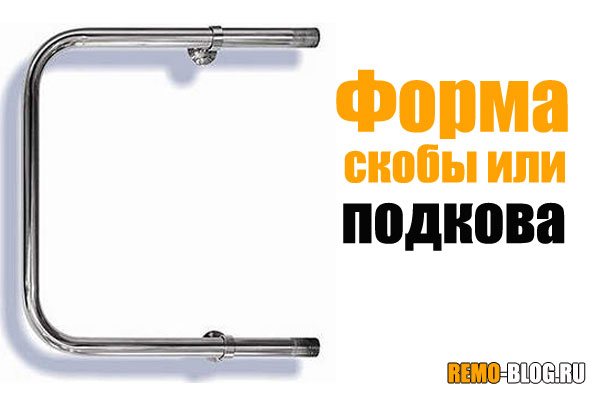
In general, there are really a lot of forms, there are even in the form of a circle, a triangle, etc. When choosing a form, you need to clearly understand that the more crossbars and ledges, the larger the drying area.
3) Material
The most important thing in the work of a heated towel rail is the material, because it is really a guarantee of long work without replacement. As a rule, all heated towel rails are made from various metals. But you need to take only high-quality options.
When buying an apartment, as a rule, you have the usual metal options, no one will install stainless steel heated towel rails, and even more so from copper or brass. This is an ordinary bent pipe, painted over regular paint. The appearance of such a dryer, and the operational characteristics, leave much to be desired, therefore it is sent to a landfill (handed over to the nearest metal reception), but we set it to normal and aesthetic.
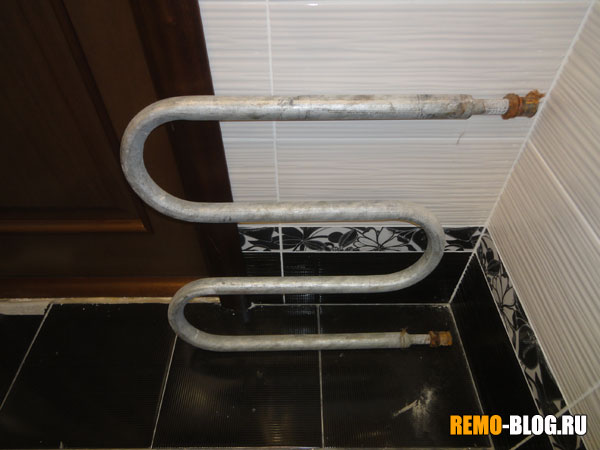
plain steel - there are models made of ordinary steel, as a rule, they are covered with chrome on top. Such options are the cheapest, but also the most short-lived; under the influence of water, such heated towel rails quickly fail and begin to leak. Average service life is 5 years.
- as well as from ordinary steel, there are chrome-plated options, but there are also painted ones. Such options last much longer, due to the fact that they are slightly affected by water. Service life from 10 to 15 years.
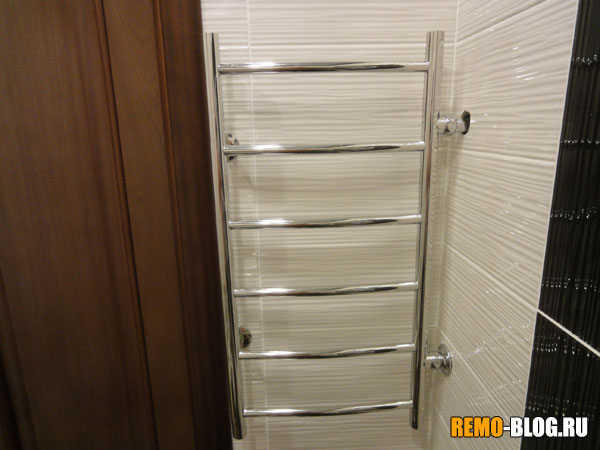
Copper, brass or aluminum towel rails - These are the most practical models in terms of water resistance. They rust for a very, very long time, and therefore can last up to 25 years. However, these species have another problem, towel warmers made of such materials are the most fragile, they are deformed even with the slightest effort, so you need to be very careful with them.
A short video on material and form
4) Price - quality
The final point of our article. So, what towel warmer corresponds to the price - quality? My choice - having traveled to many stores, I came to the conclusion that the heated towel rail should be - made of stainless steel (because ordinary steel is not practical, but cheap, and copper, brass, aluminum are expensive and very fragile) for such options a guarantee of five years, must be in the form of a ladder (due to its practicality), and must also be connected to a regular hot water riser, I am not interested in electric options.
In conclusion, I would like to say that I bought exactly this one, I am very satisfied, it looks great! Also recommended to a friend, he is also satisfied! Such heated towel rails are also convenient because you can release an air plug from it at any time (be sure to read this article).
And that's all, I think my big article really helped you.
When repairing a bathroom, obsolete equipment is replaced, which includes a heated towel rail connected to a heating or hot water supply system. When choosing a new heating device, it is necessary to evaluate not only its external attractiveness, but also the strength of the material of manufacture. Not every device is able to withstand the operating pressure fluctuations that occur in heating system apartment building. It should be borne in mind that the peak values \u200b\u200bof this indicator can reach up to 10 atmospheres. Therefore, it is so important to know how to choose a heated towel rail and what technical characteristics of the product to pay attention to as a matter of priority. matters and correct installation purchased equipment. Usually, the installation of the device is carried out before the start of the finishing finishing works in room. This is more profitable both in terms of finances and in terms of time spent on installation work. Many problems can be solved more easily using electrical models.
After watching the video, you can understand how to choose the right heated towel rail from the variety of models on the market.
What types of heated towel rails are there?
All heated towel rails on the sanitary equipment market can be divided into three groups.
Water devices
They are initially included in the standard equipment of the bathroom and are a pipe bent in the form of a coil, through which hot water circulates. At the moments when the hot water supply is turned off, the operation of the tubular product for its intended purpose is impossible until the repair work is completed.
If the device is connected to the heating system, then the period of its use coincides with heating season. This means that the water heated towel rail in this case is idle for more than three months a year. However, life does not stop and residents of apartment buildings have to look for a replacement for this equipment.
Electric towel warmers
These devices can be an excellent alternative to water models. After all, they can be operated offline, regardless of the functioning of other systems. There are also no strict requirements for the installation site of such equipment. Therefore, you can find electric towel warmers not only in bathrooms, but also in kitchens and hallways. For operation of such equipment, only an uninterrupted supply of electricity is needed. Naturally, the constant use of an electrical appliance will lead to an increase in bills for the consumed kilowatts.
Combined heated towel rails
These units combine design features water and electrical appliances, so they can, if necessary, work in one of two modes. However, many buyers are still repelled by the cost of such products.
Important! After evaluating the advantages and disadvantages of each type in relation to individual characteristics of your apartment, you can understand how to choose a heated towel rail for the bathroom so that it is beautiful, profitable and functional.
The main nuances of choosing a water heated towel rail
As stated above, technical specifications water models must correspond to the level of working and pressure testing, typical for the plumbing system of the house. In accordance with building codes and regulations, as well as the requirements of GOSTs that regulate the installation of water supply and heating systems for apartment buildings, all used water-folding sanitary fittings must be operated at a pressure of up to 6 atmospheres and above. Although theoretically the water pressure in the system should not exceed 4 atmospheres, in practice this value can vary from 2.5 to 7.5 atmospheres depending on the number of storeys of the building, its location, and the state of utilities.
Note! Before buying a water heated towel rail, you need to find out the pressure indicator in the plumbing system at home, add a few positions for possible water hammer and choose a device based on this information. Remember that all important technical parameters are indicated by the manufacturer in the product passport.
For country house With autonomous systems water supply and heating, the pressure in which does not exceed 2-3 atmospheres, the choice of a heated towel rail is not so difficult, so you can buy any model.
Why are imported models interesting?
The diameter of pipes of imported equipment differs from the diameter of domestic heated towel rails, which makes the products more elegant and expressive. In addition, the color range of devices from foreign manufacturers is much more diverse. This expands the possibilities of non-standard design of the bathroom interior.
They bribe products imported to the Russian market from other countries in a variety of forms:
- MP-shaped models;
- M-shaped;
- U-shaped;
all kinds of ladders (including those with lateral connection, with ribs different type and other configurations).
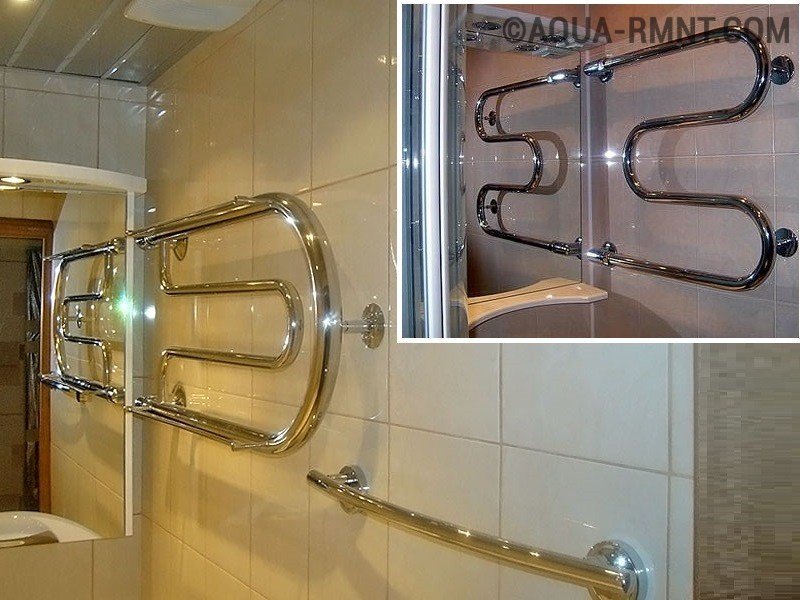
Imported models of heated towel rails are distinguished by bizarre shapes and various sizes.
When choosing a shape, do not forget about the size. After all, the availability of free space in the room affects which water heated towel rail is better to choose for the bathroom.
Rotary models, which are produced by DM (Germany), Global Ship (Italy), Korin (Finland), LVI (Sweden), Varmos (Norway), especially attract the attention of Russians. Their feature is that the products can be installed perpendicular to the wall, while they can be moved in both directions, because the angle of rotation is 180 degrees. White, gilded, chrome rotary heated towel rails can decorate any room.
Important! The presence of shut-off valves that allow servicing devices, lowering overpressure and eliminate air locks, is an integral part of imported appliances. These measures contribute to uniform heating of the device along its entire length.
Also popular with Russian buyers is German equipment such famous brands like Art-Tec, Zehnder, Emco and Arbonia. Each consumer decides for himself which company to choose a heated towel rail from the listed brands, the main thing is that the devices withstand operation taking into account Russian conditions and do not fail ahead of time.
The influence of the material of manufacture on the term of work
The quality of water used in Russian water supply systems leaves much to be desired. Models made of stainless steel can withstand the corrosive action of the coolant. The top surface of stainless steel products can be chrome-plated, polished or painted.
Painted heated towel rails are the most affordable, while polished appliances are very expensive. The equipment made of non-ferrous metals (brass, copper, aluminum) is inferior in terms of duration of use.
Advice! Stainless steel products are popular, so they are often faked. In order not to run into defective equipment, it is necessary to carefully examine the quality of the welds, as well as require documentary evidence of the origin of the goods.
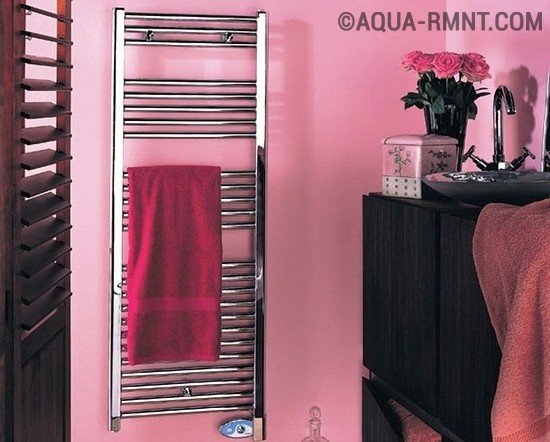
Stainless steel towel rails are different long term exploitation
It is advisable to purchase heated towel rails made of ferrous metals for country cottages equipped with individual heating systems. Because when used in apartments multi-storey buildings devices made of ferrous metals are corroded by corrosion, clogged with salts and other impurities present in the coolant, and settling in the form of a solid precipitate on inner surface pipes.
It is worth paying attention to the devices manufactured by Zehnder, Arbonia, Kermi in Germany, as well as the Czech company Korado and the Russian enterprise KZTO.
Knowing the material of manufacture of the device, as well as the degree of its resistance to corrosion processes, you can understand which heated towel rail to choose and how long this equipment can approximately last.
Operational safety of electric models
If the possibility of connecting a water appliance is excluded in the room, then which heated towel rail is better to use? Of course, electric. The undeniable advantages of these models include:
- beauty of design design;
- no leaks;
- independence from pressure in the hot water supply system;
- ease of installation;
- freedom in choosing the place of installation;
- heating temperature control;
- enable / disable if necessary, etc.
However, there is a significant drawback, which is associated with the difficulty of safely connecting any electrical appliance in the bathroom in conditions of high humidity levels. To eliminate the possibility of human injury electric shock, installation work must be carried out by a professional electrician using concealed wiring and special sockets built into the wall of the room.
Important! Electricity consumption directly depends on the power of the heating element of the electric heated towel rail, which can vary from 100 to 2000 W. Because modern models turn on and off automatically when the set parameters are reached, it is possible to save energy resources.
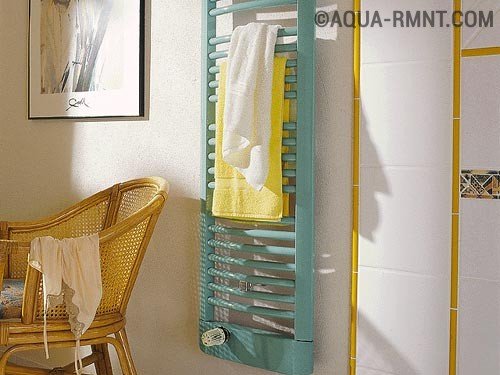
Painted models of heated towel rails make the interior of the room brighter and more unusual.
This equipment is produced by Russian and foreign manufacturers, and which towel warmer is better to choose specifically, each buyer must decide on his own. Domestic models are inferior in design, but also cheaper. Imported devices are distinguished by beauty, functionality and, accordingly, higher cost.
It is advisable to buy the device and order its installation in one place, so that a single company is fully responsible for its operation. Otherwise, the seller may say that the equipment failed due to errors made during installation. The assembly organization, upon presentation of claims, will shift the blame on the seller who, in their opinion, delivered a low-quality product. To exclude such a scenario, you can representative installation organization entrust the choice suitable equipment from a technical point of view. The appearance of the heated towel rail in this case, of course, is determined by the owner of the apartment.
To reduce the humidity in the bathroom and be able to dry wet towels, install special device called a heated towel rail. The most common type of such plumbing is a water heated towel rail, which is connected either to hot water supply or to the heating system. What characteristics does this plumbing device have, what materials it is made of and how not to make a mistake when choosing suitable option for your bathroom?
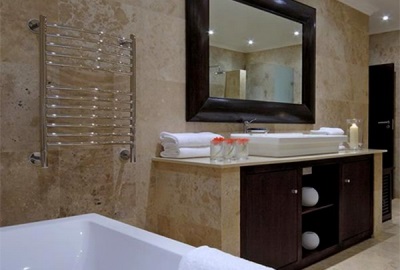
pros
- Such a device long time keeps the room dry and also heats the bathroom. This helps to protect the room from the formation of fungi and mold due to high humidity.
- Unlike electric models, it does not depend on power supply and is more economical (no need to pay for extra electricity spent), and also does not require grounding and special moisture-resistant sockets.
- In addition, the use of water type heated towel rails is safer, since there is no risk of electric shock.
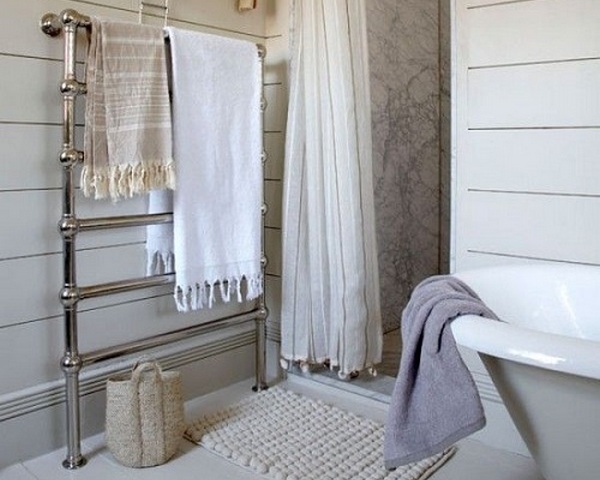
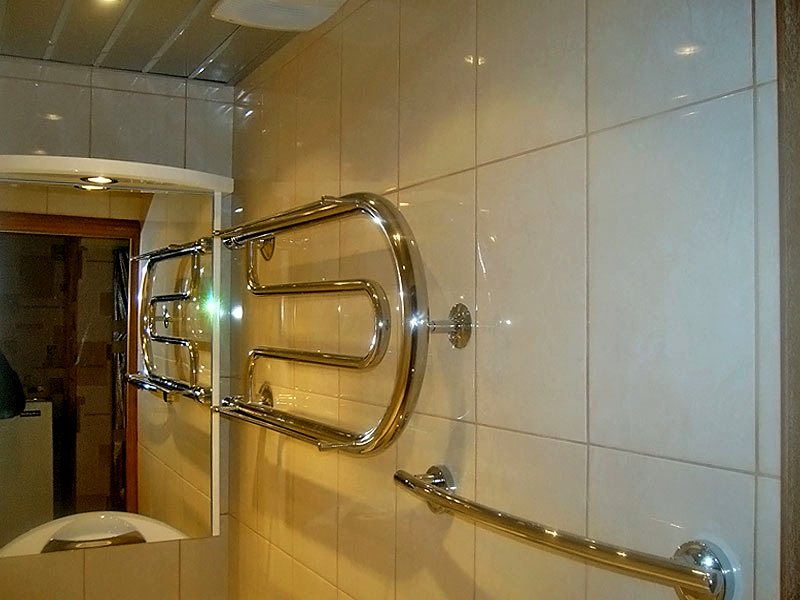
Minuses
- The device will not work if the hot water supply is interrupted (in the event of an accident or planned outages) or the end of the heating season.
- Installing a water heated towel rail is quite complicated, so for independent holding jobs require experience and expertise.
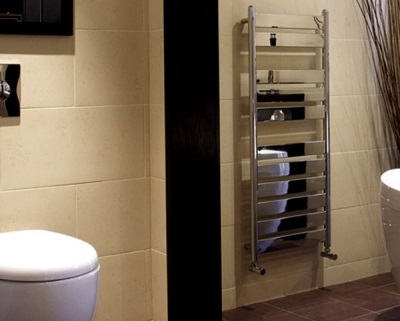
Kinds
A heated towel rail purchased for a bathroom may refer to one of the following types of these plumbing fixtures:
- To electric. Such heated towel rails are powered by the mains, so when installing them, you have to pay more on electricity bills.
- To the water ones. Their work is based on the circulation of hot water inside the device.
- To combined. They are quite expensive, but combine all the advantages of the first two types. The main advantage of the combined device is the work all year round - in winter from heating, and in summer from electricity.
The water heated towel rail, depending on the type of connection, is bottom or side. The lower option is more common, but when installing the side one, you can easily hide communications, which affects the appearance of the room.
Forms
Water heated towel rail happens:
- Standard - M-, P- or MP-shaped.
- Staircase.
- Ring-shaped.
- Zigzag.
- With shelves.
- Individual form.
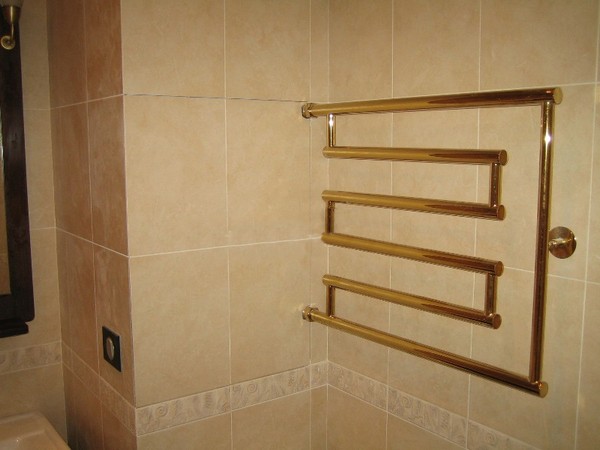
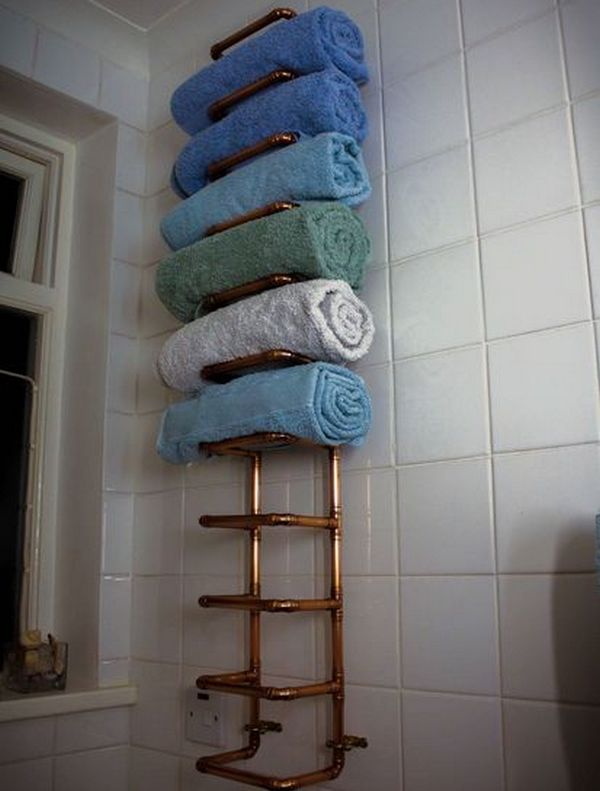
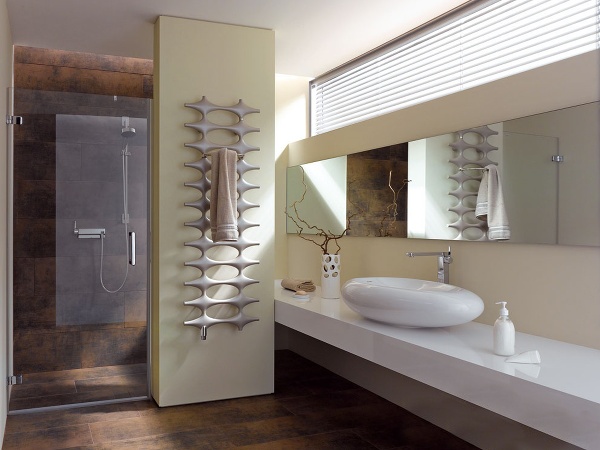
materials
For the manufacture of water heated towel rails, the following materials are used:
- Stainless steel.
- Galvanized steel.
- Black steel.
- Brass.
- Aluminum.
- Copper.
Models made of galvanized or black steel attract with safe operation, ease of installation, good technical specifications. Copper and brass products are inexpensive and attractive in appearance, but do not last very long (up to 6 years).
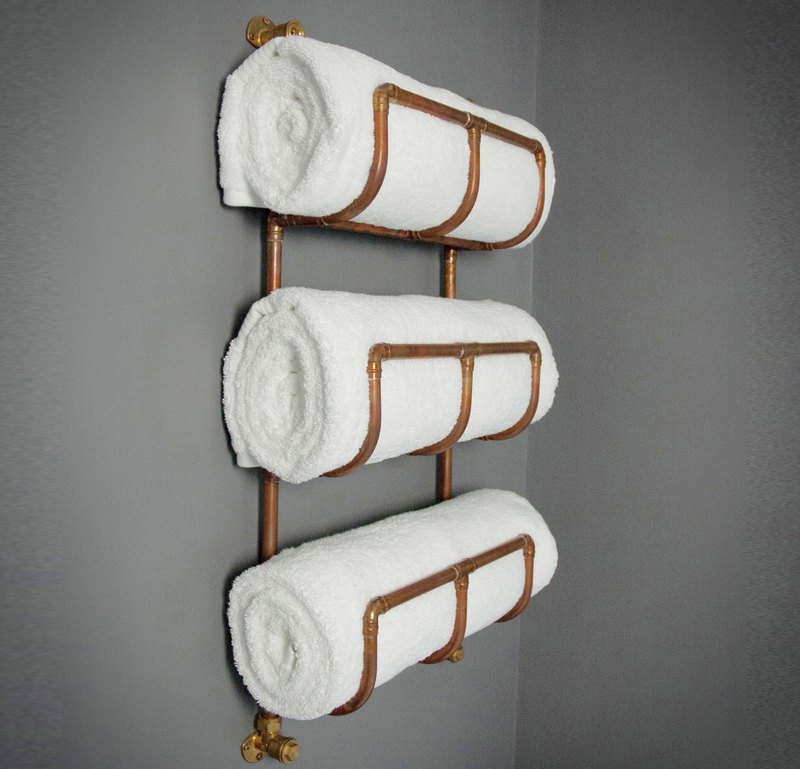
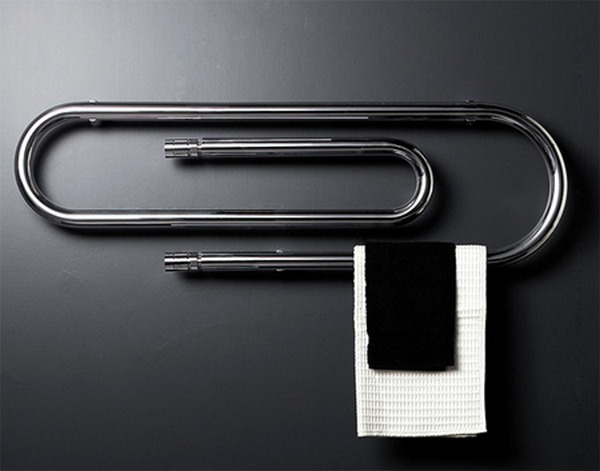
Is stainless steel a worthy choice?
Stainless steel products can be called one of the most durable. They are highly durable, corrosion resistant, and long service. Such a steel heated towel rail can last 20 years or longer.
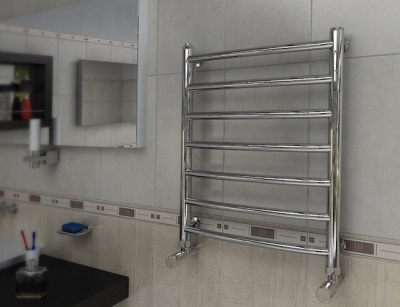
What characteristics to pay attention to?
One of the common mistakes buyers of a heated towel rail make is choosing a device based on its appearance. First of all, it is important to take into account the features of the use of such plumbing, and only on final stage choice - whether the product will fit into the interior.
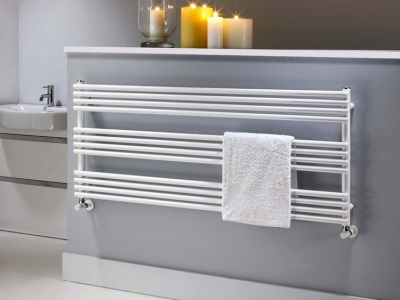
When buying a water heated towel rail, you need:
- Make sure that the product is provided with a passport, as well as a warranty card.
- Inspect the pipe carefully. First make sure it's solid. If you connect a heated towel rail to the heating system and live in a high-rise building, the water pressure in the pipes will be high and if there is a seam on the pipe, there is a high probability that it will disperse. Next, find out what material the pipe cover is made of. It can be chrome-plated or enameled, while the first option is more reliable.
- Make sure the device has an air release valve. In its absence, air may enter the heated towel rail, as a result of which its operation will be difficult.
- Take into account the nuances of installation in your bathroom. For example, by connecting a heated towel rail to the heating system, you will make such plumbing useless in the summer. If you connect your device to hot water, then the temperature of the heated towel rail will be determined by the draw-off power. If a heating connection is selected, it is important to consider the pressure in the system. With centralized heating, pressure drops are very common, but with autonomous heating they do not happen, since the pressure will be constant.
- Choose the shape of the product, taking into account the characteristics of the house in which it will be installed. For multi-storey buildings it is advised to choose a coil so that when heated, the product does not deform or collapse.
- Check if the diameter of the selected heated towel rail fits the pipes in the bathroom. If differences in diameter are found (and this is often found when buying a foreign-made model), you should additionally purchase an adapter.








